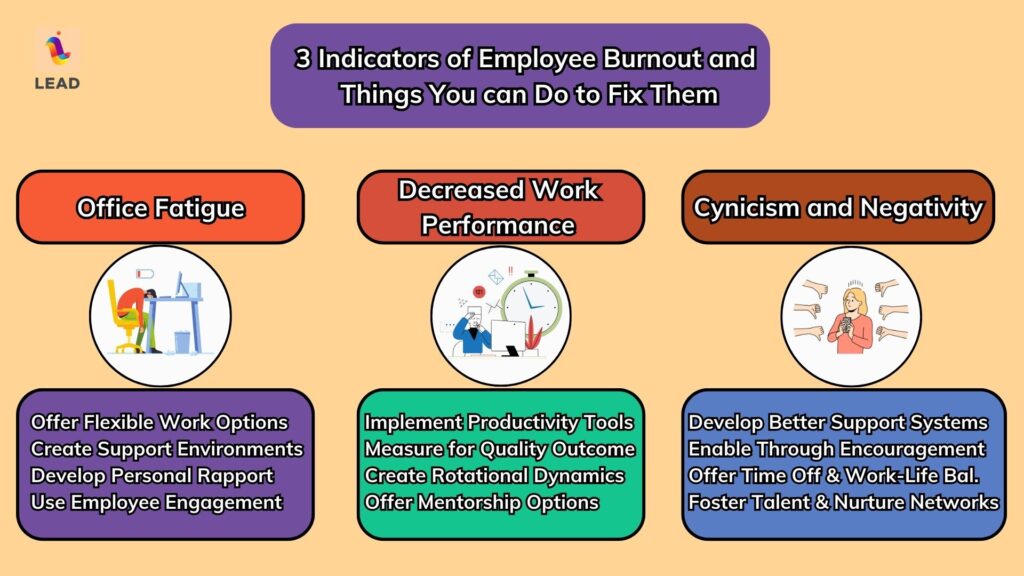Jobs in 2024 are more stressful than ever before. Working a job demands a lot more than just the regular working hours that employees put into them. Add to that the fight to keep a career trending upward and the need to develop strong professional networks and it’s easy to see why employee burnout is a major topic of discussion.
In many circumstances, employee burnout is preventable if spotted early. With the right kind of managerial and peer support, burnout can become much more easy to manage. This is important for businesses because it ensures that workforce productivity remains up and they can nurture talent effectively.
So, here are 3 signs managers ought to look for in their team members and some ways to counter them:


3 Indicators of Employee Burnout and Things You Can Do to Fix Them
3 Indicators of Employee Burnout and Things You Can Do to Fix Them
Constant Fatigue
Key Takeaways:
-
Keeping up morale is essential for keeping business productivity up. So, checking in on tired employees is essential for effective team development especially if it comes with mentorship options and knowledge management.
-
Employees who are well-supported by managers were 25% less likely to struggle with somatic symptoms of stress, 33% less likely to have a hard time getting motivated in the morning, and 56% less likely to have high work stress.
-
Certain employee engagement activities like watercooler chats and virtual coffee chats help employees remain open about their personal struggles and how they are affecting their work productivity.
Work fatigue is normal. When people work hard, they will also get tired and if the conditions are right, work fatigue is validating too. However, way too often, employees and managers find themselves overworked and underappreciated. Juggling family and personal life along with that adds more to the plate than it can take. The result is some smashed China without the right attention from others.
Employee burnout and exhaustion are also infectious and they may affect other people.
Keeping up morale is essential for keeping business productivity up. So, checking in on tired employees is essential for effective team development especially if it comes with mentorship options and knowledge management. This works not only to improve the conditions of the tired employee but also increases morale in the team. When people see managers caring for subordinates, they feel motivated and are likely to put in more effort.
As per this Forbes article:
Employees who are well-supported by managers were 25% less likely to struggle with somatic symptoms of stress, 33% less likely to have a hard time getting motivated in the morning, and 56% less likely to have high work stress. The prevalence of burnout is 58% lower among employees who experience strong manager support for mental well-being. Employees who don’t feel well supported by their manager are 4.5 times more likely to be a retention risk.
Solution
Managing worker fatigue and employee burnout requires a direct and personalized approach. Everything starts with open communication and works with a flexible schedule. Most companies now work on a hybrid model and this comes with its own kind of stress. Certain employee engagement activities like watercooler chats and virtual coffee chats help employees remain open about their personal struggles and how they are affecting their work productivity. This is the best way to support employee productivity and also create a healthy work environment for hybrid and remote workers.
Decreased Work Performance
Key Takeaways:
-
Most workers tend to start experiencing employee burnout after some weeks or months of consistent project-after-project engagement.
-
One of the best ways to counter decreasing employee performance at work is by pairing people from across the organization for virtual coffee chats.
-
Further, this is an excellent way to develop peer-to-peer mentorship programs as well as develop micro-teams where specialized project-centric skills may be developed.
Every employee’s work performance is directly tied to their levels of motivation and correspondingly, their exhaustion. Oftentimes, they need some time and space to keep up with the pace of the project.
Manager may notice a gradual drop in performance and employee engagement value from their team if they are not rotating worker operational levels optimally. Most workers tend to start experiencing employee burnout after some weeks or months of consistent project-after-project engagement.
It is important to identify not just the HR metrics like EPI and FTE to understand work output values but also the people science element of it. Studies have shown that work output and quality outcomes increase when professionals are working in an enterprise that fosters genuine connections. An organic network churn enables professionals to develop their internal enterprise networks and may contribute to cross-team collaboration opportunities opening up as well.
Solution
One of the best ways to counter decreasing employee performance at work is by pairing people from across the organization for virtual coffee chats. This also works great for employees working remotely and is especially useful for engaging digital nomads. Here’s an example from a McKinsey blog on how employee motivation should be enhanced,
One data platform company, for instance, weaved its employees’ expressed values into its overarching company value statement, allowing employees to truly live their values at work. Rather than work from the top down, leaders in the start-up observed how the highest-performing employees behaved and then made that the standard.
There are multiple reasons for doing this but the most important is that it enhances productivity. Further, this is an excellent way to develop peer-to-peer mentorship programs as well as develop micro-teams where specialized project-centric skills may be developed. For technically-heavy tasks like financial audits and agile project handling, creating multiple tasks is a poor approach. Instead, setting realistic goals with achievable margins is the way to go. This helps employees create enough breathing room to rediscover their own stride and momentum.


3 Indicators of Employee Burnout and Things You Can Do to Fix Them
Cynicism and Negativity
Key Takeaways:
-
Workplace toxicity is commonplace in businesses and a prime reason for employee burnout. This is especially true for large businesses where acidic environments get swept away in the name of career growth and profitability.
-
In many cases, worker toxicity gets put away until the skeletons are practically spilling out of the closet. When this happens, you can expect an HR and maybe even a PR nightmare.
-
Using employee engagement activities like virtual coffee chats and watercooler chat sessions. This helps develop a strong support structure for companies and their workers and in many cases, opens up new ways to solve problems.
Workplace toxicity is commonplace in businesses and a prime reason for employee burnout. This is especially true for large businesses where acidic environments get swept away in the name of career growth and profitability. However, toxic environments are a strong indicator of the worsening state of a company. No matter how large a company is, no one is too big to fail and no one can ignore their workforce’s needs and still remain profitable for long.
Toxic manager behavior is often a result of excessive pressure and it can affect subordinates. The worst brunt is often borne by interns and the high employee turnover rate visible in Gen Z hiring numbers is a telltale of why many businesses now struggle to win over skilled talent. In many cases, worker toxicity gets put away until the skeletons are practically spilling out of the closet. When this happens, you can expect an HR and maybe even a PR nightmare. That is why it is important to maintain a healthy and genuinely supportive work environment and not just for the sake of maintaining employee productivity.
Solution
Managing workplace negativity and employee frustration is a nuanced process. The conventional wisdom is that one-on-one conversations help solve worker frustrations. However, this is not necessarily true. In fact, most managers do not have the time to talk to workers individually. So, using employee engagement activities like virtual coffee chats and watercooler chat sessions. This helps develop a strong support structure for companies and their workers and in many cases, opens up new ways to solve problems. Take this Deloitte Insights article on creativity for example,
Creative organizations—those that generate new, useful, and commercially successful products and ideas—become that way by embedding creative teams within a supportive social and physical context. These supports include not just material resources—funding, equipment, and so on—but also a culture that values new ideas, appropriate mechanisms for vetting and developing them, and methods and governance frameworks that allow teams to engage creatively with internal and external stakeholders. Without such support in place, an organization risks its creative ideas dying on the vine, strangled by bureaucracy, poorly aligned incentives, unfortunate group dynamics, or an inability to find customers.
What Should Your Approach to Combating Employee Burnout?
Tackling employee burnout is a complex topic and the size of the organization only makes it harder. It’s not possible to change an entire organization’s work culture overnight, nor in six months not even a year. However, it is possible to give middle managers the tools they need to work up a strong team bond and then foster effective cross-team collaboration. Since productivity is directly tied to creativity, using smart employee engagement activities like virtual coffee chats, watercooler chats, and process-embedded mentorships also go a long way in workplace culture transformation. This is where LEAD bot offers a perfect team collaboration and knowledge management package.
LEAD bot is a team engagement platform for big businesses and MNCs on Slack and Teams. It is an all-in-one team development software with features like virtual coffee chats, buddy programs, birthday celebrations & work anniversary celebrations, new hire onboarding programs, and Pulse Surveys.
LEAD bot also offers cutting-edge Organizational Network Analysis (ONA) for large-scale organizations. C-suite execs and mid-level managers benefit greatly in their decision-making from ONA and use its highly actionable insights for building strong connections across their workforce. This enables far more forward-leaning talent development and generates greater organizational interconnectedness! Foster better organizational health, talent development, employee retention, and overall performance with this simple app!
LEAD bot is a product of LEAD.app and we also LEAD.bot’s sister app Sunrize which showcases workplace attendance by graphs right on Slack! Book a demo now!












